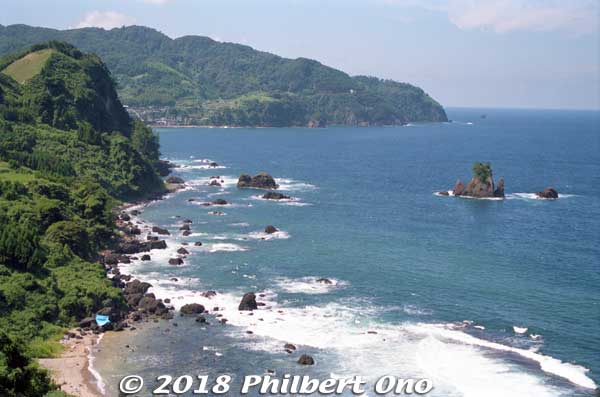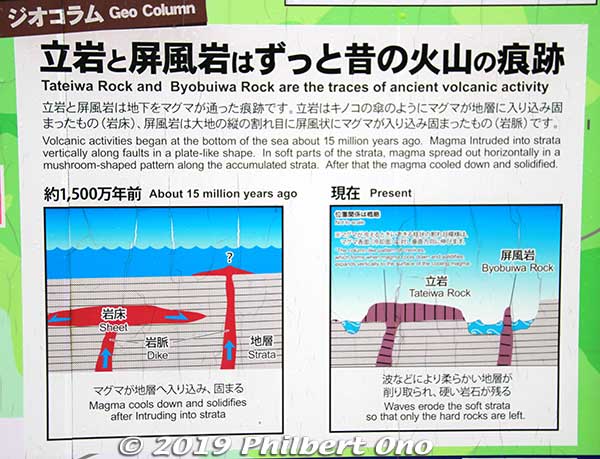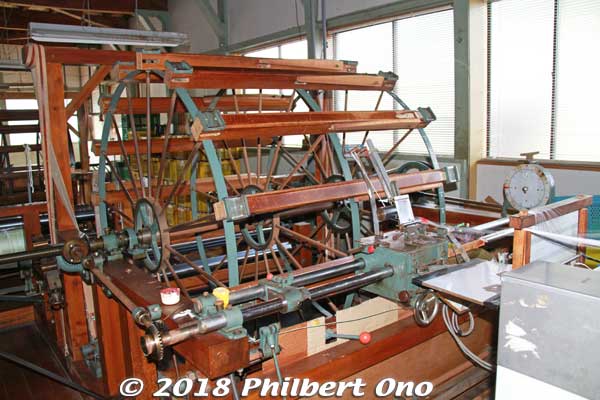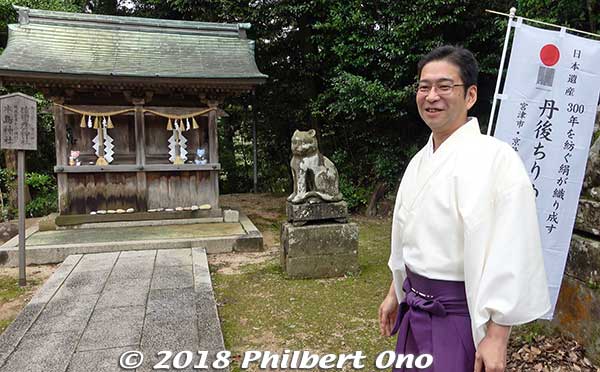
On a map, Tango Peninsula (Tango Hanto 丹後半島) in northern Kyoto Prefecture looks like a short thumb sticking into the Sea of Japan. Some parts of the coast are quite dramatic or scenic as I found out when I once bicycled around it years ago. It took a day, and it’s much easier to enjoy the coastal scenery on a bicycle than from a bus. It’s a rural area so the cars are few.
Tango Peninsula is also famous for Tango chirimen silk crepe fabrics used in high-end kimono and obi sashes (丹後ちりめん). Mention “Tango” to the average Japanese, and they most likely will answer “chirimen?” Tango Peninsula is synonymous with chirimen silk fabrics made here since 300 years ago. In Oct. 2018, I revisited Tango Peninsula to visit chirimen factories. Tango Peninsula has the city of Kyotango and the towns of Ine and Yosano.
Tango Peninsula location: https://goo.gl/maps/CNiXatqh1P92
When you tour the Tango area, you may hear about the big Kita-Tango Earthquake (北丹後地震) that struck the Tango area on March 7, 1927. About 70%–90% of buildings in Mineyama, Kyotango, and Yosano were destroyed by the quake or resulting fire. In Mineyama, 97% of buildings were destroyed and 22% of the population died. In Kyoto Prefecture, a total of 2,898 died and 7,806 injured.
*Note that “Tango” in this case is not pronounced like the tango dance. In Japanese, the “Tan” is pronounced more like “ton” or “tongue” in English.
Contents
San’in Kaigan Geopark | Tamiya Raden | Tayuh Textile Co. | Yoshimura Shouten | Kotohira Jinja Shrine | Chirimen Kaido Road | Shorenkan Yoshinoya ryokan | Alexander Wilds Interview (ryokan designer)




Western Tango Peninsula is part of the San’in Kaigan Geopark (山陰海岸ジオパーク) that extends from the western half of Tango Peninsula (Kyotango) to Tottori Prefecture. San’in Kaigan Geopark is also a UNESCO Global Geopark. This part of Japan is geologically important because it has remnants of when Japan broke away from the Asian mainland. So Tango has something for geologists too. Notable natural formations include Byobu Iwa Rock which is a partition-like rock jutting out of the ocean and Tateiwa Rock.

Tateiwa Rock (“Standing Rock”) originally was a mass of magma that erupted and accumulated within the earthen strata below the surface. The magma didn’t break the surface. However, the surrounding strata was soft and eventually eroded to expose only this hard volcanic rock called “Tateiwa” (Standing Rock). It looks like slanted columns of rock fused together.
Closest train station is Mineyama Station (Kyoto Tango Railway). Taxi available. Tateiwa location: https://goo.gl/maps/QDHmG1qArez

While cycling around Tango Peninsula years ago, I often heard the mechanical sounds of looms here and there. There are fewer of them now though.
The Tango region’s rainy and humid climate is ideal for chirimen production since silk does not work well in dry climates. So there are (or were) many chirimen factories (including mom-and-pop operations) here.
“Chirimen” (縮緬) literally means “shrunken or crimped fabric.” In the West, we call it “crepe fabric.” So it has a wrinkly or bumpy surface. We visited a few chirimen factories in Tango and talked to a few of the top people in the industry. We were very impressed by the fabric’s extremely high quality and their use around the world by major fashion brands.
Tamiya Raden

Tamiya Raden (民谷螺鈿) had this stunning silk kimono on display for us. Raden means inlay (using shell, ivory, etc.). Typically, we think of lacquerware, but they do it on fabrics.
The above kimono took 2.5 years to make and is worth more than a Lamborghini or Rolls Royce.

Company president Tamiya Kyoji (民谷 共路) answered our many questions about this amazing kimono. His father Tamiya Katsuichiro (民谷勝一郎) took two years to develop and invent a method to inlay shell pieces in fabrics and showed their first example on a kimono obi sash in 1977.
The kimono was woven with pearly shell pieces from five species of oysters. Might be hard to see which parts of the kimono are the shell inlay, but the shiny parts are not the shell pieces. Very glittery.




Mr. Tamiya showed us a whole bunch of beautiful and innovative materials that they were working on. They also supply fabrics to world-famous luxury brands, but they can’t brag about it because of a non-disclosure agreement.

Above is a replica of an obi sash that was selected and worn by Empress Michiko. (The empress did not know who made the obi. She just liked the design.) http://tamiya-raden.jp/
Tayuh Textile Co., Ltd.

Tayuh Textile Co., Ltd. (Tayuh Kigyo 田勇機業株式会社) offers tours of their chirimen textile factory in the city of Kyotango.


Before the factory tour, Tayuh Kigyo’s third-generation company president Tamoi Hayato (田茂井 勇人) explained about their chirimen manufacturing process. He showed us this chirimen material having a woven design.

These looping punch cards called mon-gami (紋紙) program the Jacquard loom to weave the design on the fabric. The holes in the punch cards tell the loom which threads are to be raised or not during the weaving process. These punch cards can be made by computer now.

Above is 3,000 silk cocoons. That’s how much silk is needed to make the silk fabric for one kimono. One cocoon has 1200–1500 meters of silk thread. Since Japan produces very little silk, most are imported from China and Brazil. The Tango region consumes about one-third of Japan’s raw silk imports. We were told the quality of silk from China and Brazil is very good.

Tayuh Textile Co. makes almost everything, from the silk threads to the fabrics. We toured their impressive factory. Above are spools of silk being made into threads.

Above is a thread twister (hatchobori) to twist the horizontal silk threads (weft) 3,000 to 4,000 times. This is a key step and how chirimen gets its crimped surface. After being woven into the fabric, the highly twisted weft threads try to untwist, creating the crimping.


Tayuh Kigyo’s factory has 60 mechanized looms and 50 of them are Jacquard looms. Very noisy and very fast-moving. One employee monitors several looms. Mesmerizing to watch.

Within Tayuh Kigyo’s factory grounds, there’s also the Garden of Hosenju (蓬仙寿の庭) designed by Shigemori Mirei (1896–1975 重森三玲), a famous Japanese garden designer.
Tayuh Kigyo free factory tours (closed on Sat. and Sun.)
Open: 8:30–18:00, Closed Sat. and Sun.
Reservations required for large groups.
Call 0772-72-0307 (in Japanese) or submit online form (in Japanese): http://www.tayuh.jp/inspection/
Address
Tayuh Kigyo (Tayuh Textile Co., Ltd.)
Asamogawa 112, Amino-cho, Kyotango-shi, Kyoto
〒629-3104 京都府京丹後市網野町浅茂川112
Phone: 0772-72-0307
info@tayuh.jp
http://www.tayuh.jp/
Online shop: http://tayu.shop-pro.jp/
Directions
From Amino Station (Kyoto Tango Railway), 5-min. taxi ride.
Parking available. Location: https://goo.gl/maps/TbEAjdM8T5y
Yoshimura Shouten

Visited a Tango chirimen wholesaler Yoshimura Shouten (株式会社 吉村商店 峰山支店). Founded in 1830 and based in Kyoto city, this is their branch shop in Mineyama, Kyotango. They are in this distinctive, traditional building rebuilt in 1930 after the big 1927 Kita-Tango earthquake.

They have a small office space on the right, meeting room on the left, a fireproof kura storehouse in the back, and lots of floor space for textile merchandise.

Above, Mineyama Branch Manager Yoshioka Hitoshi shows a PR poster of Bando Tamasaburo V posing with a Tango chirimen fabric in front of the shop’s fireproof kura storehouse. Tamasaburo V honored the store by posing here. He is one of the most famous and popular kabuki actors in Japan and Living National Treasure. He loves Tango chirimen fabrics, and kabuki costumes also use Tango chirimen.

Yoshimura Shouten also creates its own designs like this “Hollywood chirimen” prototype with the the likeness of Audrey Hepburn, Charlie Chaplin, and Marilyn Monroe.

Above, a chirimen fabric inspector uses a light box to carefully check for any defects and flaws in the material. Any defects in the material will reduce its value and the fabric (or kimono) will be sold for less.
Although Yoshimura Shouten is mainly a wholesaler, they also sell fabrics to individuals. They offer tours of their shop, but reservations (in Japanese) are required.
Address
Yoshimura Shouten, Mineyama Branch
Naniwa 17, Mineyama-cho, Kyotango-shi, Kyoto
〒627-0032 京都府京丹後市峰山町浪花17
Phone: 0772-62-1100
Directions
From Mineyama Station (Kyoto Tango Railway), short taxi ride.
Location: https://goo.gl/maps/mHChDRJs9u32
http://yoshimura-shouten.jp/
More photos of Tango chirimen: https://photoguide.jp/pix/thumbnails.php?album=1030
Kotohira Jinja Shrine

Kotohira Jinja Shrine (nicknamed Konpira-san 金刀比羅神社) in Kyotango greatly benefited from the patronage of rich, local Tango chirimen makers and merchants. Its headquarters shrine is Kotohira-gu Shrine in Kotohira, Kagawa Prefecture in Shikoku.
It mainly worships Konpira (or Kompira), the god who protects sailors, fishermen, ocean transport, navy personnel, and other seafaring people. People also pray here for business prosperity, family safety, scholastic excellence, safe childbirth, recovery from illness, and more. The shrine was mosty destroyed by the 1927 Kita-Tango earthquake so most of the current buildings were rebuilt in the 1930s.
The shrine’s Reisai Festival (例祭) is held on the second Sunday in Oct. when five floats (yatai 屋台) are pulled along the streets near the shrine and a large mikoshi portable shrine is also carried around. It used to have 30 ornate festival floats, but they were sadly destroyed by the 1927 earthquake.

Kotohira Shrine has a unique affiliate shrine named “Kishima Shrine” (木島神社) which is the left half of the shrine above. (The right-half shrine is Sarutahiko Shrine [猿田彦神社] for the god of transportation and directions.)
Kishima Shrine is unique in Japan for two koma-neko cat guardians (狛猫). Shrines usually have koma-inu lion-dog guardians (to ward off evil spirits), but only this shrine in all of Japan has cat guardians instead.


Kishima Shrine has koma-neko cat guardians because silk farmers in the 19th century kept cats to protect their precious silkworms and cocoons from rats. Rats were a major problem for the silk industry since they ate the silk cocoons and worms. So cats saved the local silk industry.
The koma-neko cat guardian statues were donated in 1832 by silk merchants and wholesalers such as the Tonomura family (外村家一族、岩滝のちりめん問屋、山家屋の小室利七) who were textile merchants from Higashi-Omi (Gokasho), Shiga Prefecture.
More photos of Kotohira Shrine: https://photoguide.jp/pix/thumbnails.php?album=1037
Address
Kotohira Jinja Shrine
Izumi 1165-2, Mineyama-cho, Kyotango-shi, Kyoto
〒627-0034 京都府京丹後市峰山町泉1165-2
Phone: 0772-62-0225
http://www.konpirasan.com/
Directions
From Mineyama Station (Kyoto Tango Railway), 800 meters. Parking available.
Map: https://goo.gl/maps/b5tK5kganr82
Chirimen Kaido Road

Our final Tango chirimen stop was the Chirimen Kaido Road (ちりめん街道), a Tango chirimen manufacturing area and distribution center in the former castle town of Yosano. The chirimen was mainly shipped to the city (Kyoto). There was a railway to Kyoto city where the fabrics would be sold, dyed, or sewn into kimono.
Chirimen Kaido Road has an easy walking route to see traditional buildings still remaining.

One home on the Chirimen Kaido Road the public can enter is the Former Bito Family Merchant’s House (Kyu-Bitoke 旧尾藤家). The Bito family was a raw silk and chirimen wholesaler since the Edo Period. Very prominent and rich local family who also became active in local government and business during the Meiji Period. The house was originally a farmhouse built and expanded during 1863 to 1930.
http://www.yosano.or.jp/chirimen-kaido/?page_id=162


This part of the house had a Japanese-style first floor, and a Western-style (Spanish) second floor. Built in 1928 and the most impressive part of the house.

The Japanese-style first floor used very expensive materials. These thin wood pillars are shochikubai (matsu pine, bamboo, and ume plum tree).

The 1st floor’s ceiling wood is very rare, made of yaku-sugi cedar wood (屋久杉). Yaku-sugi is hundreds of years old, native to Yakushima island in Kagoshima Prefecture, and now illegal to cut down.

Address
Former Bito Family House
Kaya 1085, Yosano-cho, Yosano-gun, Kyoto
〒629-2403 京都府与謝郡与謝野町加悦1085
Phone: 0772-43-1166
http://www.yosano.or.jp/chirimen-kaido/?page_id=162
Hours: 9:00 a.m.–5:00 p.m. (enter by 4:30 p.m.)
Closed Mon. (open if a national holiday and closed Tue. instead), Dec. 29–Jan. 3
Admission ¥200 for high school and above, ¥100 for children
Directions
From Yosano Station (Kyoto Tango Railway), take a bus or taxi to Chirimen Kaido.
Location of former Bito Family House: https://goo.gl/maps/out6zpYaxX72


Our guide, Aoki Jun’ichi, from Yosano Tourist Association, showed this exterior lattice design featuring the kanji character for “Tan” (from “Tango” 丹後) which is similar (by no coincidence in this case) to the kanji character for “yen” (円).

This home above housed a chirimen factory and these windows let in light and air, but kept out prying eyes from passersby in the old days (when people were shorter I guess). Chirimen makers had secrets to keep.
Our walking tour ended at the Yosano Town Hall’s Kaya Branch which used to be a train station on the Kaya Railway. Sure learned a lot about Tango chirimen. This Tango visit has forever changed my image and knowledge of it.
One thing we missed seeing was the Tango Chirimen History Museum (Tango Chirimen Rekishi-kan 丹後ちりめん歴史館) housed in a former textile factory. It is 10 min. by car from Chirimen Kaido. Free admission.
Chirimen Kaido (in Japanese): http://www.yosano.or.jp/chirimen-kaido/
More photos of Chirimen Kaido: https://photoguide.jp/pix/thumbnails.php?album=1036
I think this webpage by Kyoto Women’s University best explains about Tango chirimen silk fabrics in English:
https://artsandculture.google.com/exhibit/BgKi5_Kejz_bKw
Shorenkan Yoshinoya

Shorenkan Yoshinoya (昭恋館よ志のや) is a hot spring ryokan on the Tango Peninsula (Kyotango) where we stayed for one night. Founded in 1928, it has 11 guest rooms. The ryokan has been patronized by Japanese celebrities since the 1970s. It costs ¥17,000 to ¥18,000 per person per night including dinner and breakfast. However, during crab season (Nov. to March), the price can go up to ¥30,000 or more. This ryokan is proud of its crab cuisine.



Shorenkan Yoshinoya ryokan is probably more famous for its food, especially crab while it’s in season (Nov. to March). But it wasn’t crab season when we were there in Oct. so we didn’t have any crab. But the food was still excellent.

Another highlight of Shorenkan Yoshinoya was the two hot spring baths delightfully designed by an American. Even the dressing room for the bath named “Shoren-no-Yu” (昭恋の湯) was impressive. (“Shoren” means “Love of the Showa Period.” And “Yu” means hot spring water.) As you can see, the design was very nice. These baths are not segregated so they set different bathing hours for men and women.

The Shoren-no-Yu (昭恋の湯) bath house was originally an abandoned building that was renovated into a bath with a high ceiling and garden. Most everything was designed by Alexander Wilds and his artist wife Yukiko Oka. Wilds is an American sculptor from New Orleans living in Japan since 1985. He currently teaches art at Yamanashi Gakuin University in Kofu, Yamanashi Prefecture. (See his interview below.)



Since the ryokan celebrates the Showa Period (implied by the name “Shorenkan”), Alexander aimed to make the bath have a Showa/Taisho Period feel. It was a tough job because they had to strip this abandoned house and haul everything in and out manually. No accessible road so they had to roll the wooden barrel tub to the building by hand (so the tub couldn’t be rectangular).

The ryokan’s other bath was named “Vidro-no-Yu” (ビードロの湯), also designed and built by Alexander Wilds and his artist wife Yukiko Oka. The glass windows were a design highlight (hard to see here because of the steam and dark night). The glass door opens to a balcony with a bath.

It was great that we could try these two different baths during our overnight stay. The hot spring water supposed to lower your blood pressure and relax you.
Address
Shorenkan Yoshinoya
Taiza 1297-3, Tango-cho, Kyotango-shi, Kyoto
京都府京丹後市丹後町間人1297-3
Phone: 0772-75-2284
http://taiza.jp/en/
Directions
Nearest station is Amino Station (Kyoto Tango Railway). The ryokan can pick you up at the station for a free ride (20 min.). Inform the ryokan by the day before you arrive. Check-in after 2 pm, check out by 11 am.
Location: https://goo.gl/maps/hAHehEVDsft
Alexander Wilds Interview

I got in touch with Alexander Wilds by email in Nov. 2018 and he was gracious enough to answer my questions about Shorenkan Yoshinoya’s baths.
For Shoren-no-Yu, did you design everything? If not, which parts did you design?
I designed and built almost all, including the garden. I did not make the shelves for holding clothes in the changing room. Those were made by my friend Mr. Sashimi of Shimane Prefecture. There is also a stained glass window or two by my mother.
A lot of the “design” is invisible—the plumbing, working out water delivery and recycling.
What was your design concept behind Shoren-no-Yu?
Well, that is difficult to answer. I was given a nearly impossible task—take an abandoned house with no access to road or crane (everything had to be carried from the street up the mountain by hand) and convert it into a world-class onsen (hot spring bath) with three months working time, start to finish.
So I stripped the old building down to the bones, and used the parts left over to make the onsen. It is essentially made from scrap wood and materials. The form is what was already there, plus whatever I could make with whatever I had. The Hotel, as the name implies, is a celebration of Showa Period design, so I was aiming to make a beautiful bath in a Taisho/Showa period feeling with modern flair.
What are the main design or architectural features of Shoren-no-Yu?
I am not sure what to say—what you see is what you get. The layout was dictated by the foundations already there. The high ceiling is what remains from demolishing the second floor, the shower area is where the old staircase was, etc.
Where did you get your design ideas for Shoren-no-Yu or what inspired the design of Shoren-no-Yu? Is it reminiscent of the early Showa Period? A blend of Japanese and Western elements?
I am a sculptor by trade and training, meaning, it is all about problem solving—one has an objective (make a beautiful onsen), and whatever materials are at hand (an abandoned derelict house), and a few tools. So the design concept is take the pile of scrap and build what you can, and make it as beautiful as possible.
The “design” is the art of the art—creative problem solving, with a good sense of proportion, sensitivity for texture, color, etc. For example, I had to fill in a huge space where the garden is; I had a mountain of roofing tiles to get rid of; the garden is built of roofing tiles. That sort of thing. By the way, the reason that the bath itself is a round wooden tub is so that it could be rolled up the mountain.
The wood pillars and beams were also designed by you?
Yes. The beams were all straight. I cut them into curves with a small bandsaw and then glued/bolted them back together to make arches (like I said, I am a sculptor).
Did you also create the ceramic tiles? The artwork as well?
I had the tiles in my pile leftover from another project—they are Mexican.
What was your design concept behind Vidro-no-Yu? (Does Vidro mean “glass” in Portuguese?)
Vidro-no-Yu’s name comes from the widows. We did not name anything—that came from the owners. Those are all by my wife, Yukiko Oka. That bath is a 50/50 design by us. The old bath was dingy and dirty, so we renovated it. They wanted a rooftop bath, and it could only go in one place, and there was a limited amount of water, so I made the baths smaller to have enough water for the outdoor bath. Again, it was take what you got, and make what you can. I am quite proud of that work, by the way. Starting a design from scratch is child’s play—converting old baths into works of beauty takes much more creativity.
The name comes in respect for my wife, Yukiko Oka, and her designs. She is the artistic genius in the house. She has great taste and imagination, and I have good problem-solving skills. We make a great team that that sort of work.
How did Yoshinoya find you or how did they decide to have you design the baths?
I was living in Omori-Ginzan (Shimane Prefecture) where I had built an art gallery from old houses. Mr. Matsuba Daikichi (Gungendo) introduced me to Mr. Fukuyama who asked me to build an onsen in similar taste and style.
When did this design project start and end?
Shoren is 2003, Vidro is 2005. Both began in June when the hotel closes for the season, and opened November 1 for the beginning of crab seson.
What is your artistic/design/architectural background?
I am just a sculptor (Google my name and see my work, also for Yukiko Oka). I have been in Japan since 1985 studying art and design. I do not consciously mix Japan and the West, old and new. I do not copy, nor do I insist on originality. I just make whatever I make as best I can using whatever I have—no method, no guru.
What other rooms or interiors have you designed in Japan that the public can see?
All other architecture is in Shimane, mostly in Iwami-Ginzan. There are two buildings (I do not know current names) and the Abe House which belongs to Gungendo and guests can stay there (for a fee).
You teach in Yamanashi Prefecture?
I currently live in Yamanashi, but I will retire in March and return to western Japan (Hagi, Yamaguchi) where I hope to return to art and architecture. I will hang out my shingle and open for business April 1, 2019.
Any final remarks?
I have made art all my life, and have loved Japanese art and design since I was a little boy. I am neither rich nor famous, but I am the luckiest man alive—I get to spend my life doing what I love, making beautiful things.
Thank you Alexander Wilds!
His blog: http://alexanderwilds-japan.blogspot.com/2017/12/alexander-wilds-architecture-yoshinoya.html
Yukiko Oka: http://yukiko-art.blogspot.com/
Tango Peninsula has a lot to offer with Ine, chirimen fabrics, scenic coasts, geological features, and the food. More attractions in the area are listed below.
Other Kyoto by the Sea posts:
Amanohashidate – Heaven’s Bridge
Ine, floating fishing village
Amanohashidate (photos)
Chionji Temple
Ine Funaya Boat Houses (photos)
Tango Peninsula (photos)
Tango Chirimen silk fabrics (photos)
Kotohira Jinja Shrine
Chirimen Kaido Road, Yosano
Kurotani Washi Papermaking, Ayabe
Ayabe Farmhouse Lodge
Fukuchiyama Castle
Japanese Oni Exchange Museum, Fukuchiyama
Maizuru Brick Park
Shoeikan Restaurant, Maizuru
Yoshihara Irie, Maizuru